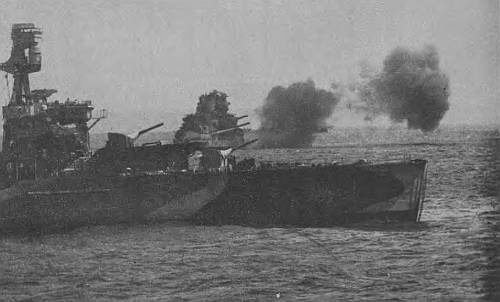- Author
- Smythe, D.H.D., AO, Commodore, RAN
- Subjects
- Biographies and personal histories, History - WW2
- Tags
-
- RAN Ships
- None noted.
- Publication
- March 1975 edition of the Naval Historical Review (all rights reserved)
Sunday, 4th June 1944
Well, sure enough, there’s been a postponement of 24 hours, and the weather (which is the reason) may make an even longer postponement necessary. At 0700 this morning, just as we’d passed the Lizard, we turned 180 degrees and since then have been retracing our steps. Close behind us another cruiser squadron is doing the same. Consisting of the US Ships Tuscaloosa and Quincy and the Britishers Glasgow, Enterprise, Hawkins, Bellona and Black Prince, they had just overhauled and passed us at the Lizard when we got word to turn back. Astern of them are Texas, Arkansas and Nevada, the old Yank battlers, and ahead of us are Ramillies and Warspite. It’s all rather disheartening, as we were all keyed up to it, but this isn’t the first experience of the kind that I’ve had and probably won’t be the last. I only hope we don’t run out of fuel earlier than all the others (which is likely) and find ourselves left behind when the attack comes.
Monday, 5th June 1944
Well, tomorrow’s the day – or as it is known throughout the world, D Day. We’ve retraced our steps again and at the moment are just turning south from the Isle of Wight with Portsmouth astern. Once again the day has been one long continuation of ships as we steamed along the coast from Land’s End to the Solent. In the last few hours the landing craft have appeared, to add to the squadrons and convoys of warships and merchant ships already at sea. In flotillas of thirty or forty ships, they are coming out from their pre-invasion ports in literally thousands, and turning south for their goal. At dusk tonight we shall go to Action Stations and remain there until it’s all over, so we’re busily preparing everything for our long vigil. Tomorrow at dawn we strike the blow for freedom.
Tuesday, 6th June 1944
We went to Action Stations at 2215 and shortly afterwards turned into the specially well-swept channel leading to the assault area. This channel, swept a few hours before by hundreds of our minesweepers, was divided into twelve narrow lanes, each being for ships or groups of different speeds. Being in the faster category, we were continually passing the others throughout the night. As far as the eye could see, the horizon to starboard was covered by the odd silhouettes of the assorted landing craft. Each flotilla separated from the next by a few cables only, they made a sight such as I never expect to see again. The power behind those serried columns of ships was brought home forcibly and the organisation, although I had already seen it all in print, became practically evident as a masterpiece in planning. Columns of 5,000 ton LSAs (Landing Ship Assault) with their davits packed with LCAs (Landing Craft Assault) were surrounded on every side by the LCT and LCI Flotillas (Landing Craft, Tank and Infantry). Large unwieldy LSTs (Landing Ship Tanks), LCFs (Landing Craft Flak), LCTRs (the rocket firing LCTs) and even LCKs (Landing Craft Kitchen) were all ploughing steadily through the choppy sea. These made up the initial D Day assault craft for the British landings only, the American ships being further to the westward, so it was not hard to believe the official statement that over 4,000 ships were taking part, besides several thousand smaller craft.

As the night darkened, the sky on our starboard and port bows was lit by brilliant flashes, and over all was a red glow as the Air Force pounded away at the batteries on the Cherbourg and Le Havre peninsulas. At about 0200 I remembered that now the Airborne Divisions were dropping down inland from the coast and shortly afterwards the transports and gliders of the later waves of paratroopers flew overhead slightly to the eastward of us. The task of these men was to infiltrate their way back to the coast, silencing such batteries as were not knocked out by the Air Force or ourselves in the hours before the main touchdown.




